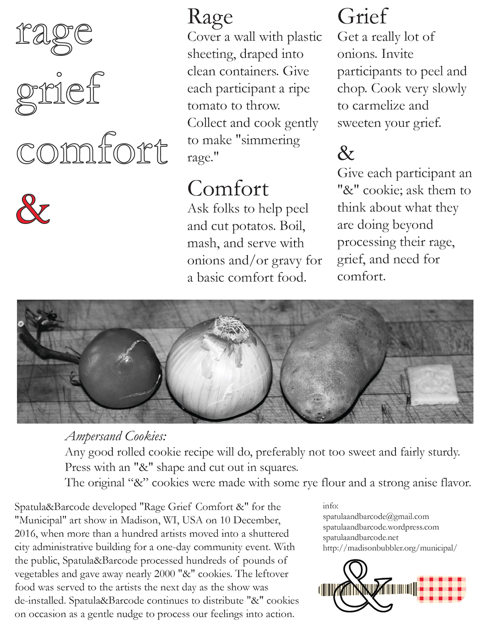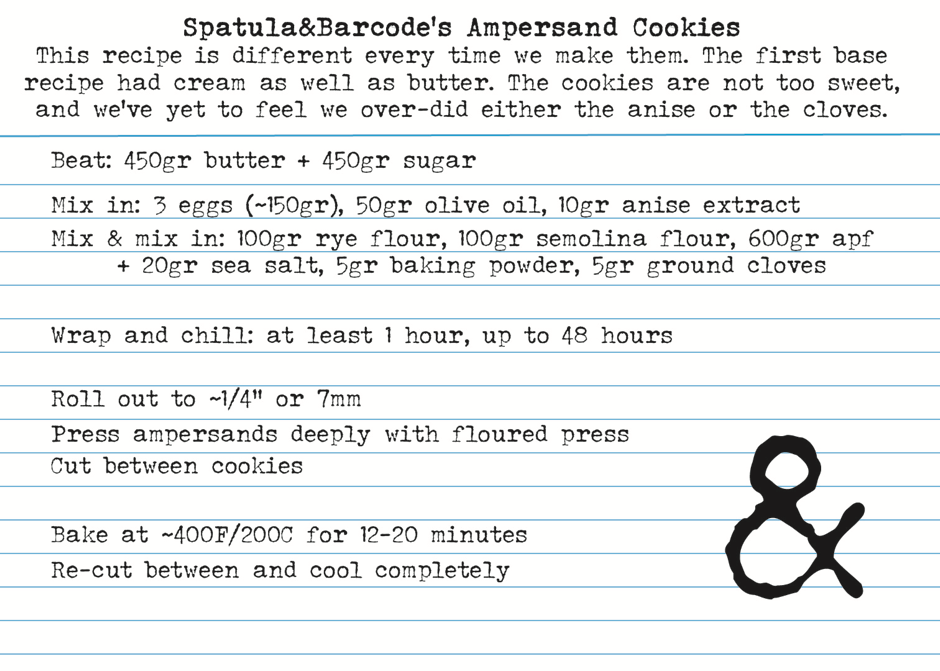Actions
In December 2016 a major city building in Madison, Wisconsin was closed for renovation, and enterprising curators installed a massive temporary art exhibition, titled Municipal. As the community was in the midst of processing the heartbreaking and horrifying election results, we created Rage Grief Comfort & with the explicit aim of moving participants through and past their immediate emotions.

Rage Grief Comfort & involved four components.
- Participants were invited to throw a ripe tomato against a plastic-covered wall labeled “rage.”

This required that we first ripen several hundred (out of season) tomatoes. This was the scene in our dining room for two weeks leading up to the show.
It turns out that this is actually a very difficult gesture to photograph. Here are some images that do not do justice to the carnivalesque scene, the satisfying thud, or the messy residue.
- At a nearby table, we sliced onions together to bring out our grief.
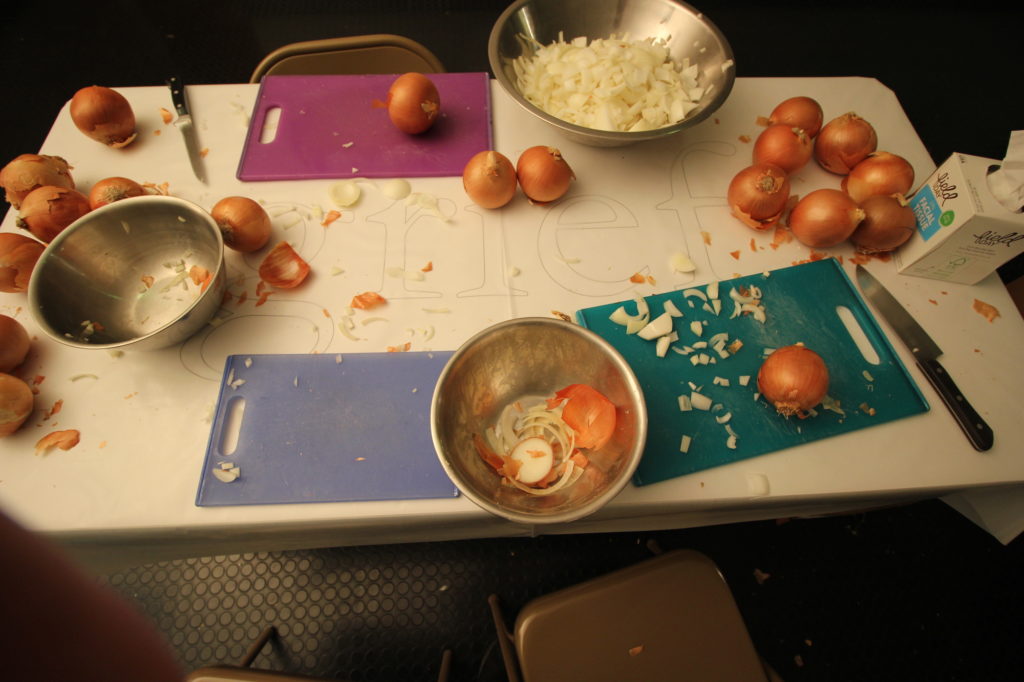
- Then we peeled, cooked, and mashed potatoes to make a classic comfort food.

- To us, the fourth element was the most crucial: as they left, we gave each participant a sugar cookie baked in the shape of an ampersand, and invited them to think about what engagement and activism would come after their emotions and their comfort.
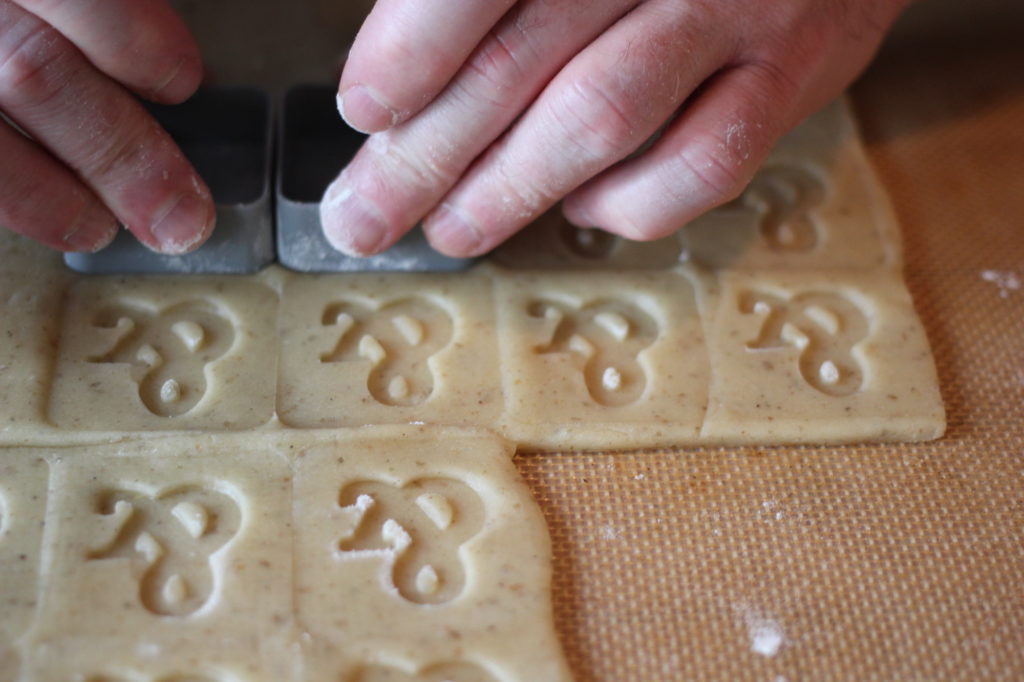

Hundreds of participants threw tomatoes and accepted cookies. We gathered the tomatoes to make “simmering rage” and fed all the food to the artists and volunteers as they de-installed the show.

Reflections
As the arts collective Spatula&Barcode, we produced Rage Grief Comfort & in response to what we saw as our communities’ need both to feel intensely the emotions in our title and to recognize and act on realities beyond and behind those feelings.
We’ve been making art as Spatula&Barcode for ten years and in that time created dozens of projects. What started off as a fun and decidedly light-hearted exploration of sociality and conversation has expanded to include works commissioned to affect specific communities and works designed by us to explore our own concerns. Past projects have investigated travel, tourism, climate, urban space, academic time, and, most recently, “Foodways” in locations in Germany, Australia, and the United States. While much of our solo work is “political,” and our collaborative work has always merged criticality with hospitality and pursued what we hope is a pro-social and communitarian “slow” politics, Rage Grief Comfort & was our first work to make (implicit) reference to an immediate, “capital P” political situation.
Three themes emerged in our reflections on Rage Grief Comfort &: affect, waste, and generosity.
While our experience with Rage Grief Comfort & left us convinced of the value of affective, and even “deflective” artworks, we also realized that feelings of shock and outrage are limited in their political impact. There were no direct references to the regime change in our project, but almost every participant chuckled knowingly or made a topical comment as they took up a tomato. While clearly an explicit contextualization was unnecessary for the piece to “work,” we also felt we wanted our space, in this repurposed public building, to be in some way apart from the noise of political media. In this sense, for us it was “not a Trump issue.”
The sense of rage that we felt from many directions was almost inchoate, and while we didn’t conceive of the work as explicitly therapeutic, we did conceive of it as a “working through” of affective experience that could otherwise be counterproductive. One of our private slogans for the work was “feel what you’re feeling, decide what you’re doing.” Nonetheless, we were taken aback at the violent satisfaction that some took in enacting the first gesture of the piece–and some of those folks didn’t bother to move through our other “stages.” As the day wore on, we became more insistent about pursuing the conversation around the meaning of the cookies; we felt it important to insist that at least contemplating action needed to follow on indulging in affect.
The ampersand is a part of our group identity and semi-ironic brand. In this project, we think of this ampersand as a reference to all the other work we are all already doing, making commitments to do, and will have to do when our needs for social justice cannot be realized through existing institutions. Like many of our participants, we experience our national and global politics as in many ways “broken,” and as constructed in the first place to serve narrow, elite interests. While we can’t ignore existing systems (to the contrary, we must pressure them more intensely), the ampersand signifies to us both the common (and futile) expectation that self-righteousness be rewarded (as in the “you deserve a cookie” meme) and as a literal reminder of the work that comes after this particular moment of pleasure and togetherness. The ampersand indicates that the cookie is not enough.
Another facet of the Municipal show that surprised us was participants’ concern that the tomatoes might be “wasted.” It’s not only that Michael was positioned in the midst of our project processing tomatoes into sauce, boiling and mashing potatoes, and caramelizing onions, nor the fact that we as a collective are known for feeding our audiences. Rather, it’s the fact that no one questioned any other resource expenditures of this (or as far as we know) any other project in the show. From other work we’ve done, we’re well aware that food waste is a unique issue that brings out anxiety, guilt, and righteousness. Moreover, we’re well aware that artmaking itself is often considered wasteful expenditure and that the confluence of art and food is particularly vulnerable to such critiques. However, we think it’s a mistake to unquestioningly bow to critiques of “waste” or assumptions that food waste in particular is either especially problematic or especially easy to remedy. In fact, one thread of our recent Foodways projects focused on developing a more nuanced and systems-based understanding of waste.
Finally, we want to contemplate the generosity and hospitality that underwrite this and all of Spatula&Barcode’s projects. Participants often thank us for our work; they experience it as a gift, and Rage Grief Comfort & was about giving experience, space, conversation, and a cookie. Volunteers gave freely of their time and both physical and emotional effort as well. It was the context of the show, “Municipal” that threw into relief the elements of gratuity and generosity that some feel can be found in all cultural production (our touchstone for these ideas has long been Lewis Hyde’s influential book The Gift). The whole experience was infused with acts of free and even purposeless giving, involving the city, the community, the organizers, the artists.
Afterlife
Explorations of the political potential of generosity are at the heart of our next phase of our projects, both scholarly and creative. For example, we are editing a volume of the journal of Performance Research on the theme “On Generosity.” We believe that pursuing diverse aims that might be seen as involving generosity (from welcoming refugees into our communities to cancelling student loans and other forms of debt) is central to refusing the neoliberal politics of the 45th U.S. presidency, just as it will be in our responses to the impact of our rapidly changing climate and our rapidly deteriorating social safety net. We hope that the Rage Grief Comfort & project serves to model—and reward—generosity.
One of the most satisfying parts of creating Rage Grief Comfort & has been its recurrence in new contexts. The project has been taken up by others and restaged in the open source format for which it was intended. It’s circulating now as part of a project by the Boston-based Design Studio for Social Innovation (DS4SI) in their Social Emergency Response Center (SERC) kit. According to DS4SI:
SERCs are temporary, emergent, and creative pop-up spaces co-led by activists and artists around the US. They function as both an artistic gesture and a practical solution. As such, they aim to find the balance between the two, answering questions like: How will we feed people—and their hunger for justice? How will we create a shelter—where it’s safe to bring your whole damn self? What will reconstruction—of civil society—look like?
This project by DS4SI was actually in the works before the election, but the concept of a Social Emergency Response Center took on new meanings on November 8, 2017. But as activist Kenneth Bailey (and many others) point out, “The social emergency was already here.” The SERC is a rich and complex response to ongoing societal inequities and we are honored to be able to include this poster as part of the kit that is sent out to participants:
We think that as the SERCs are imagined, there’s a place for something like our project as a way of saying “feelings, yes—now what?”
The project was also featured at the Corban Estate Arts Centre in Auckland New Zealand as part of The 45th Landlord, an exhibition of “responses by American artists and organisations to events occurring before and after Trump’s inauguration.” In addition to posting documentation of the Madison project, gallerists in New Zealand also baked Ampersand cookies using their own mold.

For our part, we’ve continued to bake Ampersand cookies for activists on multiple occasions including the Madison Women’s March, meetings of Madison’s Arts Activism Work Group, exhibitions of Arts for Social Change, and other civic and political occasions.
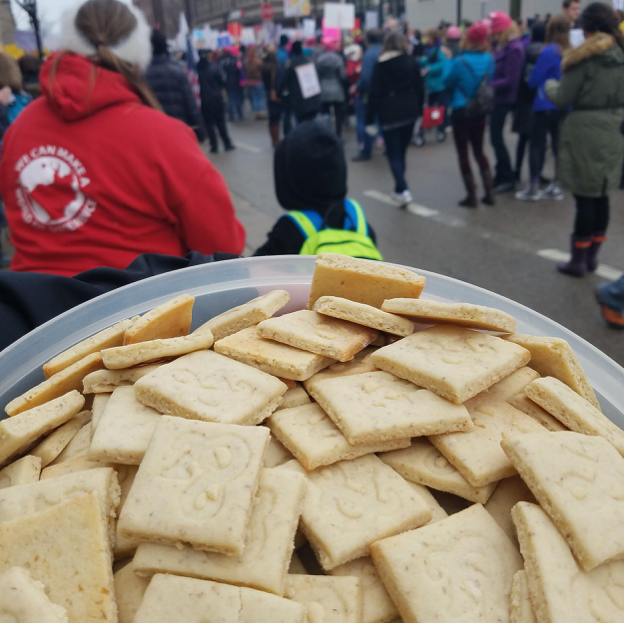
We hope that publication in this volume of Lateral will extend our open source project to new communities. We consider the idea for the project, and especially the Ampersand Cookie concept, to be free culture, available to reuse or remix. If you stage an event inspired by this essay, let us know and we’ll send you a Spatula&Barcode souvenir.
Recipe: Ampersand Cookies
Acknowledgements
Thanks to everyone who helped us to realize this project: Trent Miller and Bethany Jurewitz for staging and inviting us to participate in the Municipal show; Andrew Salyer for helping Michael to bake more than 1600 cookies; Leslee Nelson, Marin Laufenberg, Helen Klebesadel, Sigrid Peterson, Dijana Mitrovic, Tracy Curtis, and Jeff Casey for making sure that our sharp knives were only used to cut vegetables; Cora-Allan Wickliffe for finding us online and inviting us to be part of the show in Auckland; and Kenneth Bailey for adding our work to the SERC kit.


